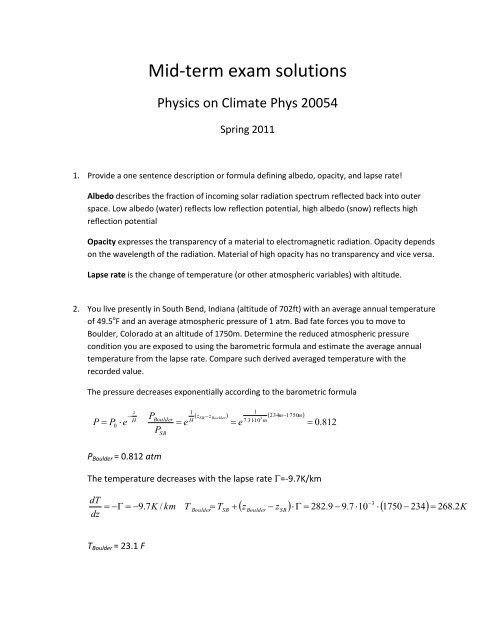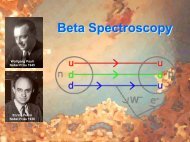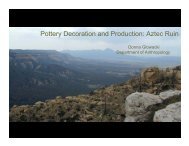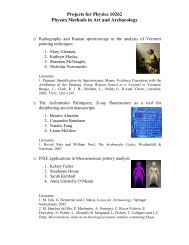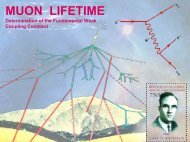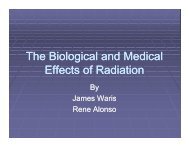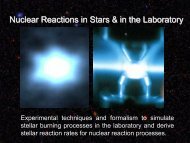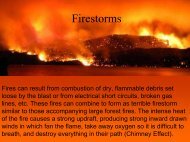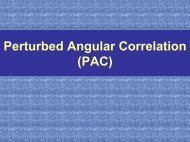You also want an ePaper? Increase the reach of your titles
YUMPU automatically turns print PDFs into web optimized ePapers that Google loves.
<strong>Mid</strong>-<strong>term</strong> <strong>exam</strong> <strong>solutions</strong><br />
Physics on Climate Phys 20054<br />
Spring 2011<br />
1. Provide a one sentence description or formula defining albedo, opacity, and lapse rate!<br />
Albedo describes the fraction of incoming solar radiation spectrum reflected back into outer<br />
space. Low albedo (water) reflects low reflection potential, high albedo (snow) reflects high<br />
reflection potential<br />
Opacity expresses the transparency of a material to electromagnetic radiation. Opacity depends<br />
on the wavelength of the radiation. Material of high opacity has no transparency and vice versa.<br />
Lapse rate is the change of temperature (or other atmospheric variables) with altitude.<br />
2. You live presently in South Bend, Indiana (altitude of 702ft) with an average annual temperature<br />
of 49.5 o F and an average atmospheric pressure of 1 atm. Bad fate forces you to move to<br />
Boulder, Colorado at an altitude of 1750m. De<strong>term</strong>ine the reduced atmospheric pressure<br />
condition you are exposed to using the barometric formula and estimate the average annual<br />
temperature from the lapse rate. Compare such derived averaged temperature with the<br />
recorded value.<br />
The pressure decreases exponentially according to the barometric formula<br />
P P<br />
0<br />
e<br />
<br />
z<br />
H<br />
P<br />
P<br />
Boulder<br />
SB<br />
e<br />
1<br />
H<br />
z<br />
z<br />
234m<br />
1750m<br />
<br />
SB<br />
Boulder<br />
e<br />
1<br />
3<br />
7.3110 m<br />
0.812<br />
P Boulder = 0.812 atm<br />
The temperature decreases with the lapse rate =-9.7K/km<br />
dT<br />
dz<br />
9.7K<br />
/ km<br />
3<br />
z<br />
z <br />
282.9 9.7 10<br />
1750<br />
234 268. K<br />
T<br />
Boulder<br />
TSB<br />
<br />
Boulder SB<br />
2<br />
T Boulder = 23.1 F
3. Black bodies of a certain temperature emit electromagnetic radiation in a certain wavelength<br />
range with maximum intensity at max . Consider Death Valley in Southeastern California with a<br />
typical temperature of 120 o F and Nome, Alaska at winter time at a typical temperature of -<br />
14.6 o C. De<strong>term</strong>ine max for both regions assuming black body conditions. Judging by the pictures<br />
what is the Albedo for each location.<br />
Death Valley, California<br />
Nome, Alaska<br />
NommDeath Calley, california<br />
<br />
max<br />
<br />
2897<br />
T<br />
D<br />
nm<br />
Death Valley : T<br />
Nome : T<br />
259K<br />
322K<br />
<br />
max<br />
<br />
max<br />
8.966nm<br />
40%<br />
11.205nm<br />
90%
4. Consider the emission temperature of the polar ocean for an incoming solar Flux of<br />
F=1370W/m 2 . Choose the albedo and emissivity parameters for summer and winter<br />
conditions as shown in the pictures and de<strong>term</strong>ine the amount of absorbed flux and<br />
reflected energy flux.<br />
Arctic Ocean, summertime<br />
Arctic Ocean, wintertime<br />
F<br />
0<br />
1370W<br />
/ m<br />
summer 7% 98%<br />
F<br />
ref<br />
2<br />
0.07 1370<br />
96W<br />
/ m<br />
2<br />
F<br />
abs<br />
(1 0.98) (1<br />
0.07) F<br />
0<br />
27.2W<br />
/ m<br />
2<br />
winter<br />
80%<br />
99%<br />
F<br />
ref<br />
0.81370<br />
1096W<br />
/ m<br />
2<br />
F<br />
abs<br />
(1 0.99) (1<br />
0.8) F<br />
0<br />
2.74W<br />
/ m<br />
2
5. The atmosphere as well as the ocean is categorized by the physical properties in the<br />
different altitude or depth layers, respectively. Explain why the temperature in the<br />
mixed layer of oceans is constant and why the temperature in the lower Stratosphere<br />
(Tropopause) remains constant. What is the underlying physical process responsible for<br />
this effect?<br />
The temperature in the mixed layer of the ocean is de<strong>term</strong>ined by convection between<br />
surface water and water in the deeper layers of the layer. This warrants rapid heat<br />
exchange and equilibrates the temperature across the layer. The temperature in the<br />
lower stratosphere layer (or Tropopause) is constant because the absorbed energy flux<br />
from the thermal radiation of earth surface is balance by the emitted radiation flux .<br />
6. Name three aerosols which affect the climate conditions or earth and explain the origin<br />
and the impact of these aerosols in the atmosphere.<br />
SO 2 volcanic or industrial origin, accumulates as aerosol in stratosphere reflecting solar<br />
radiation and reduces such the heating of atmosphere<br />
Carbon results from biomass burning and industrial production, CO 2 absorbs thermal<br />
radiation from earth, causing greenhouse effect<br />
Dust, water vapor reduces incoming solar flux and eventually affects the albedo and the<br />
reflection of incoming solar energy flux
7. Consider a flux of 500 W/m 2 of visible light entering the upper layer of the Troposphere<br />
at an altitude of 10 km. Assume an average density 500 g/m 3 . What is the flux of visible<br />
light reaching the surface of the earth considering an absorption cross section of<br />
sunny =10 -26 cm 2 for a sunny day and cloudy =10 -25 cm 2 for a cloudy day.<br />
Smoky Mountains, sunny day<br />
Smoky Mountains, hazy day<br />
F<br />
F e<br />
0<br />
(<br />
,<br />
x)<br />
dx<br />
F e<br />
0<br />
N<br />
<br />
m<br />
A<br />
air<br />
<br />
d<br />
sunny :<br />
F<br />
W<br />
500<br />
m<br />
2<br />
e<br />
6.02210 <br />
500<br />
29<br />
23<br />
10<br />
30<br />
4<br />
10<br />
W<br />
450<br />
m<br />
2<br />
smoky:<br />
F<br />
W<br />
500<br />
m<br />
2<br />
e<br />
6.02210 <br />
500<br />
29<br />
23<br />
10<br />
29<br />
4<br />
10<br />
W<br />
177<br />
m<br />
2<br />
On a sunny day only 10% of the solar light is absorbed, on a foggy day more than 60% of<br />
the incoming light is absorbed.


